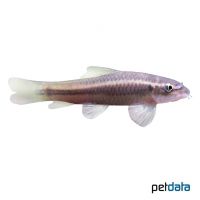Stone Roller (Crossocheilus latius)
| Stone Roller Crossocheilus latius | |
|---|---|
| Name | Stone Roller |
| Name Lat. | Crossocheilus latius |
| Family | Carps |
| Family lat. | Cyprinidae |
| Order | Carps |
| Order lat. | Cypriniformes |
| Origin | South and Southeast Asia |
| Habitat | Mountain streams |
| Diet | Omnivore |
| pH | 6.5-7.5 |
| Behavior | Peaceful |
| Keeping | Group |
| Care Level | Easy |
| Reproduction | Oviparous |
| Breeding | None reported |
| Life Span | 6-10 years |
| Protection | No |
| Metric Units | |
| Size | 12-15 cm |
| Temperature | 18-24 °C |
| Hardness | 5-15 °dH |
| Aquarium | 100 cm / 200 l |
| US Units | |
| Size | 4.7"-6" |
| Temperature | 64-75 °F |
| Hardness | 89-267 ppm |
| Aquarium | 50 gal |
Distribution and habitat
The range of the Indian Algae Eater extends from India through Myanmar to southern China. They live there in the shallow waters of small tributaries and mountain streams with tree roots and dead wood as well as sandy bottoms covered with gravel and stones.
Maintenance
The aquarium should have a dense border planting, with numerous hiding places (roots, stones, caves) and provide sufficient swimming space. A substrate of round gravel and sand, bright lighting that promotes algae growth and a slight current is ideal.
No ammonia, ammonium and nitrite should be detectable, the nitrate value should not exceed 100 mg/l. To ensure the water quality and oxygen content, a filter and heater adapted to the aquarium size is required, as well as lighting for the species-appropriate day-night rhythm of the animals.
Diet
They eat the plant cover (growth) of stones, wood, plants, etc. and the microorganisms contained therein. In addition, algae leaves, crushed peas, zucchini, scalded spinach and dry food (pellets, tablets) with high vegetable content (spirulina, kelp) should be offered. In addition, some live food such as mosquito larvae, cyclops and daphnia, which is also accepted in frozen form.
Only as much should be fed as is eaten immediately (in a maximum of 10 minutes). A regular and varied diet promotes health and increases resistance
Behaviour and compatibility
They are swimming fish and at least 5, but preferably more Indian Algae Eaters should be kept together. Among themselves it can occasionally come to harmless territorial disputes. They are very peaceful towards other, even smaller fish and can be kept well in a community tank
In principle, only mutually compatible fish species with similar requirements to the water condition and water temperature may be socialized.
Sex dimorphism
The sexes have no external distinguishing characteristics. Adult males are slightly more slender than females
Reproduction and breeding
There are no known reports of successful breeding in the aquarium.
Important
They are very good algae eaters, even grazing the lawn from brush algae. However, fine feathery plants also serve as food for them when there is a lack of green food
Higher temperatures are not well tolerated by the fish in the long run, as they inhabit cooler streams in their natural range.
The well-being of the fish should be monitored regularly. Temperature should be checked daily, pH, hardness and nitrate levels at least every 14 days. Regular partial water changes are recommended, even when contaminant levels have not yet reached the upper limit. Sudden changes in water quality should be avoided. Newly introduced fish must be accustomed slowly to the water in the aquarium.
Further literature can be found in your pet store.
References
Text: Werner Winter; Image: petdata
Source: BMELV (1998): Tierschutzgutachten - Haltung von Zierfischen (Süßwasser); ENGELMANN (2005): Zootierhaltung - Tiere in menschlicher Obhut: Fische, Verlag Harri Deutsch
- Gemäß § 21 Abs. 5 Tierschutzgesetz idgF
